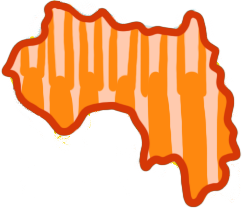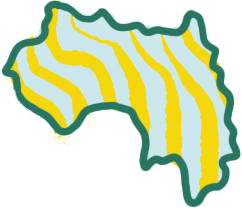Text
In this chapter you'll learn how to:
- ask someone for their name
- give your name to someone else
- recognize some variations in the ways that people do introductions
"What is your name?"
When someone wants to ask your name, you will hear the following: I tɔɔ di? That expression is made up of three words. The most important is tɔɔ which means 'name'.
(NOTE: You may also hear tɔɔ pronounced like tɔgɔ, tɔkɔ, tɔxɔ, etc. This is typical for many words. "Intervocalic velars" [G, K, and X-like sounds between vowels] are often not contrastive in Manding. They are simply different pronunciations or "accents". In standard written Maninka, whoever, they are normally dropped.)
You already learned i when we covered the greetings. It means 'you' in the singular.
(NOTE: Remember, you may also hear the pronoun i as ile and the pronoun n as ne or nde; you'll learn more about this in "Pronouns". For now, consider them interchangeable.)
When we combine i + tɔɔ then we get a possessive noun phrase that simply means 'your name'.
The word di means 'how'.
So if we put it all together we have a single sentence that looks and can be broken down like this:
I+tɔɔ+di?
YOUR + NAME + HOW?'What is your name?'
So when it comes to people, we can say that tɔɔ means 'first name'. That said, tɔɔ is also the word that is used when talking about the name of things in general. More on that a bit later in the "Bonus" section...
Before we cover how to respond, let's take a second to cover last names.
This might seem unnecessarily formal for Westerners, but last names are an important part of social relationships in West Africa. (You'll learn more about this in "Last Name Shout-Outs".) In fact, people sometimes might start by asking you for your last name.
The word for last name is jamu or si. If someone wants to ask for your last name, they could simply replace tɔɔ with jamu:
I jamu/si di?
'What's your last name?''
More typically however people will say something simpler by dropping di ('how'):
I jamu/si?
'Your last name (is)?'
In some cases, people ask for last names using the word diman (also sometimes pronounced and written duman) which is derived from another word di meaning 'pleasing; sweet; good'. Note that this is not the same as the word di meaning 'how'; they are homonyms because they are spelled the same, but they are distinct words.
I jamu diman?
'Your good last name (is)?'
"My name is..."
Alright, so how do we respond to I tɔɔ di? and I jamu?
To respond you only need to make two small changes.
First, you switch the second person singular pronoun i to the first person pronoun n (or ne; again you'll learn more about this in "Pronouns"):
N tɔɔ ...
'My name is ...'
Second, you replace di with your name!
In some cases, you may hear people insert le after tɔɔ/jamu.
N tɔɔ le Adama.
'My name is Adama.'
In this circumstance, le is what linguists call a "topicalization particle" that adds emphasis or stress to the word that it follows. It isn't required, but some people use it systematically.
Saying "My name is …" can be summarized as follows then:
N tɔɔ (le) …
'My first name is …'
When it comes to last names, people may respond using the same structure:
N jamu/si (le) …
'My last name is …'
For instance:
N jamu Jalo.
'My last name is Jalo.'
But oftentimes, they will use a simpler form:
N + LAST.NAME
'Me + LAST.NAME'
(as in, "I am a Smith/Doe, etc.")
For instance:
N Jalo.
'I am a Jalo' (Lit. 'I/me Jalo')
Combined with the previous section this gives us exchanges that might look like this:
– I tɔɔ di?
– N tɔɔ (le) Adama.
– I jamu?
–N (jamu le) Jalo.– What's your name?
– My name is Adama.
– What's your last name?
– My last name is Jalo.
(NOTE: Since you can introduce yourself now, you might also be eager to say "I am from America/France/etc." We'll get there soon! It's covered in "Verbs in the Present".)
Variations
The forms that we just covered are more or less standard forms in Maninka. That said, you might hear a few variations that result from different regional preferences and the fact that people don't always answer one another in full robot-like sentences.
In terms of shorter variations, people will often simply drop di ('how') since it is implied:
I tɔɔ/jamu?
"(What's) your first/last name?"
Alternatively, people often use another word, the contrastive particle don, that we covered in "Greetings Extended":
I tɔɔ don?
''And your name (what is it)?''
Otherwise, depending on where you are in Manding-speaking West Africa, you might hear a range of regional variations where another word appears between tɔɔ/jamu and di:
I tɔɔ ko/ye/bɛ di?
'What is your name?'
That may seem like a lot.
For now, stick with the standard Maninka form of putting nothing between tɔɔ/jamu and di when it is a question (e.g., I tɔɔ di?) or le when you are answering (e.g., N tɔɔ le Adama). Just know that you might need to able to recognize all the possible forms:
N tɔɔ+∅/le/ko/ye/bɛ+Adama'My name is Adama'
This is important because you might hear some variation in a single exchange. For instance, let's say that someone asked me what my first name and last name was. They might use nothing at all (∅) and I'd be free to respond with nothing at all (∅) or any of the other options: le, ko, ye or bɛ.
– N teri, i tɔɔ di?
– N tɔɔ ko Adama.
– I jamu ye di?
– N jamu le Jalo.– My friend, what's your name?
– My name is Adama.
– What's your last name?
– My last name is Jalo.
Bonus: "What's this (thing)'s name?"
Alright, earlier I said that tɔɔ means 'first name' when it comes to people, but that it more generally just means 'name' when it comes to things out in the world.
This means that we've picked up a new skillset.
If we replace i or n with the demonstrative pronoun nin ('this') then we can now unambiguously ask "What is this thing's name?":
Nin tɔɔ di?
'What is this thing's name?'
(Lit. 'How is this thing's name?')
Actually, if we replace nin with any other noun, we can ask the name of any person or place. For instance:
So tɔɔ di?
'What's the town's name?'
Or:
Moso tɔɔ di?
'What's the woman's name?'
Summary
Ayiwa! We covered the following about introductions & names:
- To ask someone their first or last name, you use the following:
I tɔɔ/jamu di?= 'What's your first/last name?''
- To respond to any question about your first or last name, you use the following:
N tɔɔ/jamu (le)+...= 'My name is...''
- Both of these models can vary depending on if people put a word following
tɔɔ/jamu:N tɔɔ/jamu+∅/le/ko/ye/bɛ+...
- You can use the same sentence structure to acquire new vocabulary by asking for them of people, place and things:
Nin tɔɔ di?: 'What is this (thing)'s name?'
Vocab
Coming soon n'Ala sɔnna!
- tɔɔ
- (first) name
- jamu
- last name
- si
- last name (lit. 'race; kind'; type')
- I tɔɔ di?
- What's your (first) name?
- Jamu diman/duman?
- (And your) good last name (what is it)?
- I si?
- Your last name? (Lit. "Your kind?")
- N tɔɔ (le) X
- My first name is X
- N [X]
- I am a [last name]
- I tɔɔ/jamu (don)?
- (And) your first/last name [is]?
- Nin tɔɔ di?
- What is this thing's name?
- X tɔɔ di?
- What's X's (first) name?
- X jamu/si?
- What's X's last name?
Vocab list will be here someday!
Flashcards will be here someday!
Exercises
Exercises will be here someday!




